S.K. Dunstall's Blog, page 17
January 29, 2019
Cover reveal – Stars Beyond
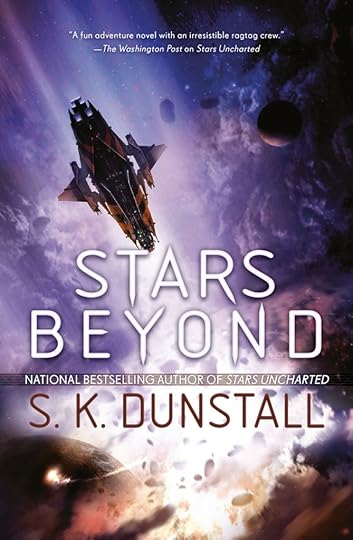
We got the okay to show you the cover for Stars Beyond. It looks great.
January 27, 2019
What do you hear or see when you read?

Progress report – there’s always one last-minute fix
Sherylyn is doing a final read-through before we send our completed Stars Beyond manuscript in to our editor.
There’s always one change that you have to scramble to fix
before the final send.
In this book, it’s this:
Our heroes have defeated one of the bad guys (bad girls) by knocking her out with a strong tranquilizer. Four paragraphs later (at the end of that same fight) up she pops, trying to kill them.
She’s supposed to be unconscious.
Hmm. It needs a little work, I think.
These are the embarrassing mistakes we hope don’t make it
into the book. Thank goodness for editors. They pick up a lot of these things
if they slip past us.

Now, back to the blog
A few weeks back, on Twitter, @shingworks
asked people to vote on whether they heard words or saw images when they read
novels. The comments are interesting.
It made me think about what I see/hear when I read books.
I lean toward the visual myself. I see the story as a movie,
in scenes—with three important exceptions.
What do I see?
It’s like a dream, where you’re watching something unfold. People speak, and action happens, but I don’t hear them speak, I see their mouths move and know what they’re saying, but there’s no sound. Their words are automatically in my brain.
I also notice that even if the author provides a description of a character, I visualize my own character according to how they ‘sound’ in my head. (‘Sound’ here meaning how I visualize them.) I can sometimes go back and reread a book and find a character is, say, blonde with fair skin where I had imagined them as darker, with dark hair.
Interestingly, as I write this, I find I am reading the
words aloud in my head, so I think that I write differently to the way I read.
What are those three exceptions?
I said there were three exceptions.
If the author describes sounds in the book, I often hear the sounds. Cars honking, street noise, the blast of a rocket taking off. Music in the background. (Although, if you describe specific songs that have iconic film clips, I will then also see the film clip. The graveyard and the wedding in Guns ‘N’ Roses November Rain, the faces in Queen’s Bohemian Rhapsody, driving into the country town in Cold Chisel’s Flame Trees.)
Secondly, if I hear an audio-book, sometimes I will hear the
characters after that. I know that after hearing Emily Woo Zeller read Stars Uncharted, I have now started to
hear Jacques and Carlos speak. They’re great. (The others are too, but she
really added an extra dimension to these two.)
And of course, there’s the lines. In the Linesman books the
lines have always sung for us.
January 23, 2019
Revisiting an old post
We get a lot of questions from readers about whether we’d like to write more Linesman books.
We often refer them to an old post we wrote when we were starting to write Stars Uncharted which talks about some of the stories we’d like to cover in that universe.
If you’re interested, and haven’t read it, here’s the link. The post is
titled So
much to write, so little time.
January 19, 2019
Progress report January 2019

Book news. We have a new
publication date for Stars Beyond. It’s
22 October 2019. We’re looking
forward to it.
We have also seen the cover, which we can’t show you yet.
Love it.
The completed rewrite of Stars Beyond is due at the end of January. Sherylyn has her headphones on, listening to the Microsoft Read-Aloud function.
I’m following her edits, accepting or rejecting changes.
We try to read all our books aloud. Reading aloud to each other is good, when you have the time, because you smooth the writing together. However, even when you do this, you miss some basic issues because you read the words you expect to see, so you don’t always pick up things like missing words.
A total stranger reading aloud will read the words, but we read what we expect to see. That’s why it was so great when Mum was with us. She read each word.
The read-aloud function in Word reads each word, and it reads it in a monotone. It picks up things we don’t see.
Sherylyn’s been listening for three full days now. It’s a big job, but important. She’s found a lot of missing commas, commas that should have been full stops, typos (if the reader can’t understand the name, it spells it out, which is a definite indicator there’s a typo) and just jerky words in general.
She’s also picking up lots of missing words, repeated words
and awkward paragraphs.
We’re starting to think about the story we want to work on
next.
January 14, 2019
Hobbiton
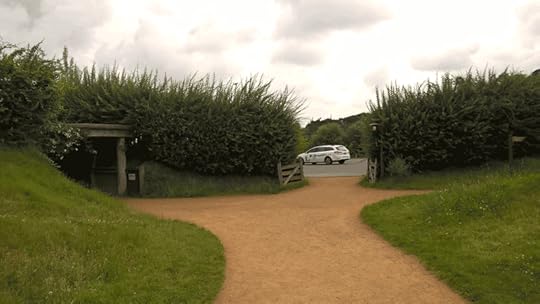 The one almost-empty car park in the whole of Hobbiton. This is where the bus drops you off for the tour.
The one almost-empty car park in the whole of Hobbiton. This is where the bus drops you off for the tour.There’s a former convict settlement in Tasmania, a penal colony. It’s the prison they used to house convicts in back when the British first settled Australia. By all accounts, it was a brutal place to live back in those days. Nowadays it’s an historic site and one of the state’s biggest tourist attractions.
 Nothing says you’ve arrived like a sign to Hobbiton.
Nothing says you’ve arrived like a sign to Hobbiton.Port Arthur went through a period of neglect, where people
left the buildings to rot and fall down, sometimes actively pulling them down
because they wanted to eliminate the terrible past. Eventually, the government
stepped in and started preserving the buildings and what was left of the huge sandstone
walls. As a result, it’s a mix of preserved buildings, immense sandstone walls and
acres of manicured green lawns.
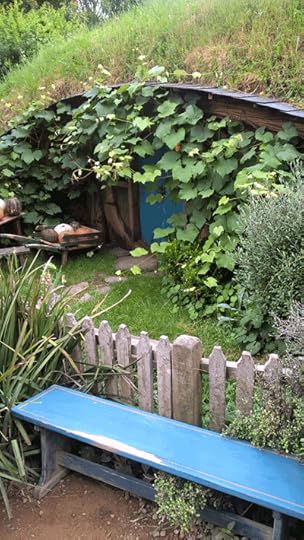 There was only one hobbit house you could go into (not this one) — that was so you could take photos.
There was only one hobbit house you could go into (not this one) — that was so you could take photos.Despite its past, despite the tourists, it’s a beautiful
place to visit. Despite all the deaths, despite all the horror of its past, it’s
a peaceful place. It’s a place just to walk, and to contemplate.
As I walked around Hobbiton it invoked in me that same kind of tranquillity that Port Arthur does
I’m not saying Hobbiton is hiding a terrible past, it but it did make me feel the same way. Maybe it’s because in both places you come in via a frenzied entryway.
In Port Arthur you enter through the gift shop. That’s where the crowds are. Once you’re past that, however, it’s lovely.
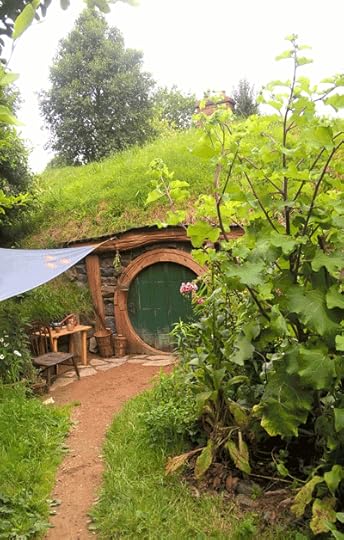
At Hobbiton, you come in through the car parks. Note the plural.
There’s one whole car park dedicated just to RVs (camper vans, for those of us
in Australia and New Zealand). It was full, so you can image what the other carparks
were like. There was a bus park, also full. And what looked to be two or three
car parks—or maybe it was just one big one. All packed.
The bus from the ship dropped us off at the gift shop. We
didn’t have much time to browse for our tour bus arrived.
Hobbiton is on a working farm. You can’t visit the site
yourself, you must book and take a tour.
 Such attention to detail. There were little gardens everywhere–some vegetable, some flowers.
Such attention to detail. There were little gardens everywhere–some vegetable, some flowers.You wait for your bus near the gift shop. At the appointed time,
you get onto the Hobbiton tour bus and are driven through lovely, green farmland.
I did say it was working farm, didn’t I? Somewhere along the way a guide joins
your bus. She, or he, starts to tell you about Hobbiton as you roll through the
countryside.
Some facts. This is not the Hobbiton that was in Lord of the
Rings. That Hobbiton was pulled down afterward filming and the whole area
restored to farmland. If I recall correctly, when the location scout landed (in
a helicopter) at the farm and knocked on the farmhouse door, the rugby was on. I
don’t know if it was final, but these Kiwis take their rugby as seriously as we
Aussies take our Australian Rules football. And our rugby—at least in some
states. The farmer told him to come back when the rugby was finished.
 They spaced the tours well, so that even though busloads were going through at a time, you felt as if it was mostly just you and Hobbiton, and maybe one other tour off in the distance.
They spaced the tours well, so that even though busloads were going through at a time, you felt as if it was mostly just you and Hobbiton, and maybe one other tour off in the distance.Luckily for us, they did.
This is the Hobbiton from the Hobbit movie. Because they’d already had so many tourists come looking after Lord of the Rings, when the film company wanted to rebuild the set for the Hobbit the farmer said, sure, provided this time they made it out of more permanent materials, and didn’t pull it down afterwards.
 More attention to detail.
More attention to detail.From this came the amazing tourist destination you can visit
today.
I’m not going to talk much about the tour itself, except to say, “Go do it”, and show you the pictures. I seem to have lost my pictures of Bag End, and of the Green Dragon inn, and Sam Gamgee’s house, but you know what they look like.
I have to say, Bilbo Baggins certainly had the best house in Hobbiton.
We both absolutely loved it. Not only that, the tours were paced
enough so that even though there were crowds, it didn’t seem crowded. And because
you were in the middle of a farm, you really felt like you were at the Shire.
 I could go on forever. My camera packed up half-way through, sadly. But … gorgeous.
I could go on forever. My camera packed up half-way through, sadly. But … gorgeous.
January 6, 2019
In the footsteps of the Lord of the Rings

Progress report
The last week has been super busy for us. It’s BICHOK* all the way. We’re onto the next draft of Stars Beyond, very conscious of the looming January deadline, writing fast. A month before the end if the novel and while we’re happy with how it’s going, we’d love two more months to polish it. (We don’t really, we’d just procrastinate until that last month. We always do have this last minute panic.)
The book still hasn’t got its final line. It’s done, and the
bad guys vanquished, etc., but we never know how to finish these things properly.
We’ll keep playing until the very last day.
In other news, our editor sent us a preview of the cover. We
can’t show anyone yet, but we love it.
* BICHOK = Butt in chair, hands on keyboard
In the footsteps of the Lord of the Rings
Did you know that a Weta is a New Zealand insect? I didn’t. I do now.
The second tour we did on our Lord of the Rings New Zealand
trip was ‘In the footsteps of the Lord of the Rings’, in Wellington. It
included … wait for it … drumroll … you guessed it. A tour of a Weta workshop.
It wasn’t technically the Weta workshop (which was a little disappointing, because I really wanted to see their workspace). It was a purpose-built showroom where they took you around and showed you various bits that they’d built and it was pretty cool.
We were allowed to take photographs in the outer room (hence you see Gandalf, and Gollum, and the doorkeeper) but not once you went past the door. Gollum was amazing, by the way. It doesn’t show in the photograph, but his eyes seemed to follow you around the room.
The guide who showed us around worked at Weta (not as a tour guide, as one of the creators). Tip. If you want to work at Weta, I hope you’re at home right now, making things out of matches and pieces of wire and anything you can find around the house. You need to be able to think creatively about everyday objects and show that you can think outside the box.
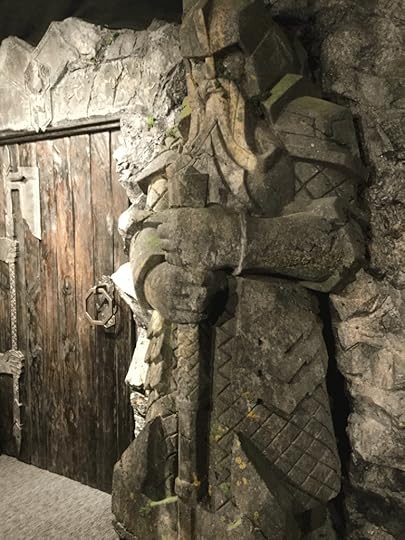
Past the door we were taken to a series of rooms. I won’t list them all. There was a whole wall of weapons. Actually, I think there were two walls of weapons. One for technological weapons, one for swords and bows and things like that. There were monsters and non-human creatures. (Our guide passed around a hand.) We talked about latex, and how they don’t use it any more, because eventually everyone becomes allergic to it. John Rhys-Davies became particularly allergic, as he was in latex every day. Plus other good stories about the various items—not all of which were Lord of the Rings related.
The two things I loved most. One was the gun was one from District 9, which they passed around for us to hold. It was heavy, deliberately designed with added weight, so the actors didn’t look as if they were carrying around fake weapons. The other was Aragorn’s ranger costume. Sitting in the corner, discreet and quiet and just perfect for a ranger. We weren’t allowed to touch that.
After Weta, we toured some of the locations around Wellington where Lord of the Rings was filmed. Including the site of the very first take. Can you recognise it? I didn’t, but most of the tour did. It’s where the hobbits tumble down the hill. We also saw where they hide from the Nazgul. I’m not sure if that was in the same location, just further down the hill, or another.

Our bus driver regaled us with stories about how, because they didn’t want people to know they were filming LOTR, the crew made the vans up to look like army vehicles and told everyone it was an army exercise. And how they made people up from local martial arts schools like the hobbits do the tumbling. How one of them tumbled the wrong way and missed the mattress below and dislocated his shoulder–and that was the take they used in the film.
On the way we got to see spectacular views of Wellington (including some amazing luxury homes along the beach), and got lots of entertaining gossip. Like how Viggo Mortensen, who is a method actor and used to stay in costume, got arrested at least twice for wearing a sword around the city.
Very entertaining, very interesting, very enjoyable.
Next week—Hobbiton. Come back if you want to hear about it.
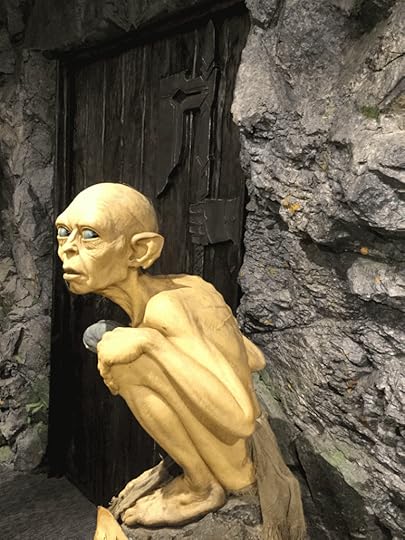
December 30, 2018
Books read 2018
I haven’t forgotten that I promised two more Lord of the Rings tours from New Zealand, but this is the end of the year and it’s time for our annual “Books we read and liked” over 2018.
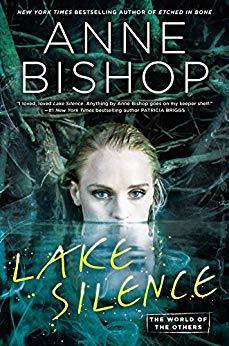
This was a year of classics. We read, or re-read, a lot of what we deem the modern urban fantasy classics. Ilona Andrew’s Kate Daniels books, Patricia Briggs’ Mercy Thompson books (first time reading these, and loved them). And, of course, there was a new Anne Bishop Others’ book, Lake Silence, which we read as soon as it came out.
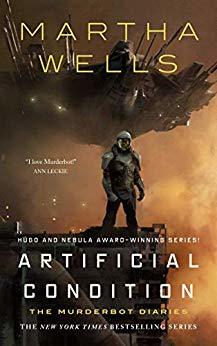
We both read, and loved, the three Murderbot books that Martha
Wells put out this year. Artificial Condition, Rogue Protocol, and Exit Strategy. They were great.
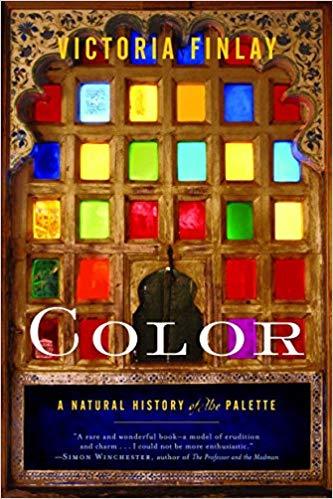
We also picked up a couple of non-fiction volumes. One of them is Color: A Natural History of the Palette by Victoria Finlay. It’s an older book, but very interesting, about how paint colors originally came about. Highly recommended for any fantasy writer, chock-full of idea generating topics. The other is edited by Dan Koboldt and is called Putting the Science into Science Fiction. It’s posts from a website where experts talk about their fields of expertise, and some of the misconceptions that authors make. It’s a fantastic book for generating science fiction ideas.
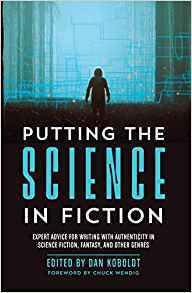
Expect some ideas for our novels to come out of those two
books. Particularly the one talking about
color.
Recommendations for this year. All the above books, of course, but we’ve
picked out these two specifically.
Sherylyn recommends
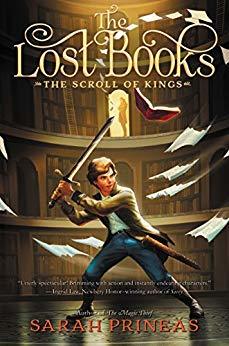
Sarah Prineas’s middle grade novel, The Lost Books, about a boy who wants to be a librarian. (Funny how there are so many books about
libraries and librarians around.) (I
loved it, too.) One of the things we
both loved about it was that even though Alex had run away from home, he still
loved his family and they loved him. (Hope
that’s not a spoiler.) If you like the Magic Thief series, you should like this
book, too.
Karen recommends
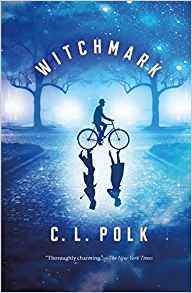
Witchmark by C. L.
Polk. I wanted to like this book because
I loved the cover. I’m glad it turned
out to be a good story as well. It’s a steampunk,
WW1 era m/m fantasy, if you can imagine that, about a doctor, also a witch, who
runs away from home because he doesn’t want to be enslaved to his sister. It
sounds crazy but it works.
Next week, it’s back to New Zealand, and a tour of WETA.
December 23, 2018
December 22, 2018
Canterbury Station, Mt Sunday and Lord of the Rings
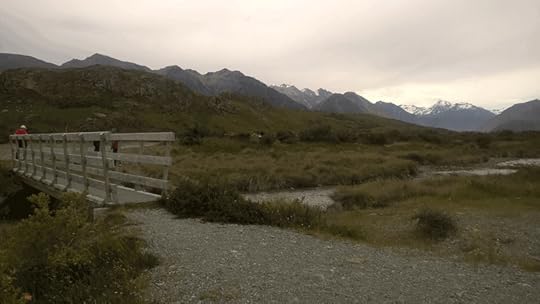 My exceptionally ordinary photograph of Mt Sunday, which is not the mountains behind (which I initially thought) but the big rock on the left side of the picture.
My exceptionally ordinary photograph of Mt Sunday, which is not the mountains behind (which I initially thought) but the big rock on the left side of the picture.So, we’re back from our cruise to New Zealand (and Tassie, because,
why not stay on the ship another five days).
Both islands (or is that all three) were fantastic, as you’d
expect.
And we have internet again.
Yay. It’s amazing the
connectivity you take for granted until you don’t have it. Or, rather, you can have it, but you have to
pay a lot for it.
In New Zealand we did a Lord of the Rings theme. We took four
tours, three of which were Lord of the Rings (LOTR) related. I’m going to talk
about those over the next few weeks, interspersed with some usual end of the
year blogging stuff.
I used my phone to take photos, didn’t wear my glasses most of the time. As a result, my photos are terrible. But I’m going to inflict them on you anyway. If they’re really bad, I’ll get some stock photos as well, just to show how good things really looked.
Our first LOTR trip was to through the Canterbury plains and
up to Mt
Sunday. This was the set for the exterior of Edoras, which was where the
Rohan people lived.
We were told before we booked that there was nothing left of
the set there. We just wanted to see it, and to see some of the glorious
scenery that New Zealand provides. It
was a nine hour tour. The ship was in port for ten hours, but you had to be
back in nine, so you can imagine how tight the time was. (Tip. For a tour like this, always book
through the ship, because they guarantee to wait for you if you do. If you book
it through a private operator, they won’t wait.)
The tour started at 8:00am.
We didn’t get onto the port until after 8:30.
We spent at least three hours being driven through the Canterbury plains, and getting some interesting facts about the countryside, about farming, and how it has changed. For example, even though it looks lush and green, there isn’t much topsoil. Erosion is a real problem. The area used to be used sheep and wheat, but then they started using those massive irrigators which is lowering the water table and doing a lot of other damage. Who’d have thought, says me, with some cynicism, because I live in a country where we’ve done exactly the same thing. You’d think we’d learn by now, wouldn’t you. Nowadays, it’s dairy now and grass.
Anyway, enough of that.
Back to LOTR.
After the plains our bus started into the Southern Alps. The weather was overcast, but pleasant. A beautiful day in beautiful, beautiful, country. Another guide, Cheryl, joined us. She was a local, and she and her family had camped out in the alps all their life.
She also told us—which Barry, our bus driver hadn’t—that Barry had worked with Peter Jackson as a security person in a number of Jackson’s films.
As we went into the mountains we started to get Lord of the Rings stories. A lot from our guide, Cheryl, but some from Barry, too.
There was the tale of the station owner, the photographer and
the helicopter. They had an agreement with
the station owner that he wouldn’t let anyone on his land to view the filming,
but he ended up taking a photographer over in his helicopter. The pictures were
published. Jackson’s company decided to sue, because they did have a contract. But
then someone let the set horses out one night, and they needed a helicopter to
round them up. Guess who had a helicopter
close by?
They got their horses within a few hours and but I believe that the station owner came out on top–at least monetarily.
Why did someone let the horses out?
Ugly fandom rearing its head. Apparently some people felt so strongly that Peter Jackson shouldn’t be making Lord of the Rings they went out of their way to sabotage the filming.
We finally got to the site.
You could still see snow on the alps in the background, even though it was
summer. The scenery was breathtaking.
There was a wind. Apparently it was mild. Guide Cheryl showed us the picture of Eowyn (Miranda Otto) standing on the outside of the hall at Mt Edoras with her hair swirling one way and a flag swirling the opposite way. This is not a fake. The wind really does swirl like that. (You might see it in the video below.)
We posed with swords and axes and Barry took a photo of me with a sword (quite heavy), but my phone really doesn’t take good photos. My head was blurred. That’s one picture you are not seeing.
On the way back we stopped for lunch at a memorial hall in a country town that reminded of all the country towns of my childhood. Volunteers fed us juice, champagne, sandwiches and cake. It was the best food we’d had on the whole trip. (Don’t, whatever you do, get on a ship thinking you’ll get gourmet food. You won’t. You’ll get more food than you can eat, and it’s okay, but nothing to write home about. You can eat all day (and all night.) By the end of the cruise I was craving some good bibimbap, or crispy noodles, oh, and a decent pasta.) This beef sandwich, with it’s soft grain bread, pickles, and cheese, was heaven.
On the way back, Barry told us a little bit about how he’d
come to work for Peter Jackson. He’d been a policeman, worked for a while in
the police museum, and had collected information about a New Zealand murder
case that Jackson based his film Heavenly
Creatures on. Barry’d had quite a
career, believe me.
When we went to get back in the bus, we found we had a problem. The rattling over the dirt roads had loosened the ignition barrel (if that’s what you call it—it’s the thing that holds the ignition) and the ignition had dropped into the barrel. It had dropped so far down that he couldn’t get the key in to turn the bus on.
We had a tense half hour (for Barry, not for us, we stood around
and enjoyed the scenery and talked to each other) while Barry tried to get the ignition
thingy back up far enough for him to turn the key.
We got back to the port an hour after the last tender was supposed to leave. But because the tour had been arranged by the ship, it waited, it waited for us.
Sadly, we didn’t get to see anything of Akaroa, which looks a
beautiful little port town.
Maybe next time.
All in all, it was a wonderful day.
Edoras as it was in the movie, courtesy of YouTube.
December 11, 2018
Who’s the smartest?

So my smart watch isn’t so smart when it doesn’t have its internet umbilical cord.
We’re cruising from Australia to New Zealand. We don’t have internet. (Well, we could have internet, if we choose to pay 79c per minute. It gets cheaper the more you purchase, but the maximum package is ten hours for $199. It feels like the internet prices you paid twenty years ago.)
But anyway, time-wise New Zealand is two hours in front of Australia, so we have to put our clocks forward. And my Versa Fitbit, which is also my watch, can’t manage it.
So far as I can work out, you can’t change the time on the Fitbit. It has to be changed in the controlling program, which is on my pc at home.
There may be a way to change it otherwise, but I don’t know how. So right now I’m going around with a watch that’s set to permanently two hours too slow.
I’d like to think that the smartphone isn’t that smart, but the phone is controlling me, really. I’m not controlling the phone.
That’s smart.




